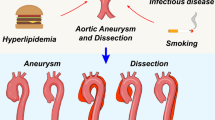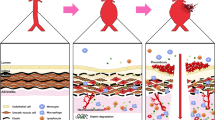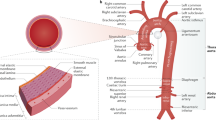Abstract
Aortic dissection and aneurysm are common clinical problems with life-threatening consequences; they are also the hallmark of several genetic diseases, including Marfan's syndrome (MFS). In spite of clinical and surgical advances that have increased life expectancy for affected patients, cardiovascular manifestations remain significant contributors to morbidity and mortality in MFS. Dissecting aortic aneurysm in this disorder is accounted for by mutations in fibrillin-1, the major component of the microfibrils associated with elastin in the elastic fibers of the aortic media. Genetic studies of human patients and murine models have yielded invaluable insights into the pathophysiology of aneurysm formation and progression in MFS. They have also revealed a previously unappreciated role of microfibrils in regulating transforming growth factor and bone morphogenetic protein signaling. As a result, exciting new hypotheses have emerged regarding the pathogenesis of MFS, as well as opportunities to explore translational applications of this information that may be relevant to various manifestations of the disease.
This is a preview of subscription content, access via your institution
Access options
Subscribe to this journal
Receive 12 print issues and online access
$209.00 per year
only $17.42 per issue
Buy this article
- Purchase on Springer Link
- Instant access to full article PDF
Prices may be subject to local taxes which are calculated during checkout
Similar content being viewed by others
References
Thompson RW et al. (2002) Abdominal aortic aneurysms: basic mechanisms and clinical implications. Curr Probl Surg 39: 110–232
Pyeritz RE (1997) Marfan syndrome and other disorders of fibrillin. In Principles and Practice of Medical Genetics (3 vols), 1027–1066 (Eds DL Rimoin et al.) New York: Churchill Livingstone
Murdoch JL et al. (1972) Life expectancy and causes of death in the Marfan syndrome. N Engl J Med 285: 804–808
Silverman DI et al. (1995) Life expectancy in the Marfan syndrome. Am J Cardiol 75: 157–160
Shores J et al. (1994) Progression of aortic dilatation and the benefit of long-term β-adrenergic blockade in Marfan's syndrome. N Engl J Med 12: 1335–1341
Salim MA et al. (1994) Effect of β-adrenergic blockade on aortic root rate of dilation in the Marfan syndrome. Am J Cardiol 74: 629–633
Haouzi A et al. (1997) Heterogeneous aortic response to acute β-adrenergic blockade in Marfan syndrome. Am Heart J 133: 60–63
Rossi-Foulkes R et al. (1999) Phenotypic features and impact of β blocker or calcium antagonist therapy on aortic lumen size in the Marfan syndrome. Am J Cardiol 83: 1364–1368
Rios AS et al. (1999) Effect of long-term β-blockade on aortic root compliance in patients with Marfan syndrome. Am Heart J 137: 1057–1061
Morse RP et al. (1990) Diagnosis and management of infantile Marfan syndrome. Pediatrics 86: 888–895
Bentall HH and DeBono AA (1968) A technique for complete replacement of the ascending aorta. Thorax 23: 338–339
Gott VL et al. (1991) Composite graft repair of Marfan aneurysm of the ascending aorta: results in 100 patients. Ann Thorac Surg 52: 38–45
David TE et al. (2001) Results of aortic valve-sparing operations. J Thorac Cardiovasc Surg 122: 39–46
David TE et al. (2002) Aortic valve-sparing operations in patients with aneurysms of the aortic root or ascending aorta. Ann Thorac Surg 74: S1758–1761
Karck et al. (2004) Aortic root surgery in Marfan syndrome: comparison of aortic valve-sparing reimplantation versus composite grafting. J Thorac Cardiovasc Surg 127: 391–398
Cattaneo et al. (2004) Surgery for aortic root aneurysm in children: a 21-year experience in 50 patients. Ann Thorac Surg 77: 168–176
Luciani et al. (2003) Fate of the aortic root late after Ross operation. Circulation 108 (Suppl 1): II61–II67
Sisk HE et al. (1983) The Marfan syndrome in early childhood: analysis of 15 patients diagnosed at less than 4 years of age. Am J Cardiol 52: 353–358
Gillinov AM et al. (1997) Cardiac operations in children with Marfan's syndrome: indications and results. Ann Thorac Surg 64: 1144–1145
Silverman DI et al. (1995) Family history of severe cardiovascular disease in Marfan syndrome is associated with increased aortic diameter and decreased survival. J Am Coll Cardiol 26: 1062–1067
Gott VL et al. (1999) Replacement of the aortic root in patients with Marfan's syndrome. N Engl J Med 340: 1307–1313
Finkbohner R et al. (1995) Marfan syndrome: long-term survival and complications after aortic aneurysm repair. Circulation 91: 728–733
Abraham PA et al. (1982) Marfan syndrome: demonstration of abnormal elastin in aorta. J Clin Invest 70: 1245–1252
Dietz HC et al. (1991) Marfan syndrome caused by a recurrent de novo missense mutation in the fibrillin gene. Nature 352: 337–339
Handford PA et al. (2000) Fibrillin: from domain structure to supramolecular assembly. Matrix Biol 19: 457–470
Mizuguchi T et al. (2004) Heterozygous TGFBR2 mutations in Marfan syndrome. Nat Genet 36: 855–860
Putnam EA et al. (1995) Fibrillin-2 (FBN2) mutations result in the Marfan-like disorder, congenital contractural arachnodactyly. Nat Genet 11: 456–458
Sakai LY et al. (1986) Fibrillin, a new 350-kD glycoprotein, is a component of extracellular microfibrils. J Cell Biol 103: 2499–2509
Isogai Z et al. (2003) Latent transforming growth factor β-binding protein 1 interacts with fibrillin and is a microfibril-associated protein. J Biol Chem 278: 2750–2757
Rosenbloom J et al. (1993) Extracellular matrix 4: the elastic fiber. FASEB J 7: 1208–1218
Brooke BS et al. (2003) Extracellular matrix in vascular morphogenesis and disease: structure versus signal. Trends Cell Biol 13: 51–56
Faury G (2001) Function-structure relationship of elastic arteries in evolution: from microfibrils to elastin and elastic fibres. Pathol Biol 49: 310–325
Collod-Beroud G et al. (2003) Update of the UMD-FBN1 mutation database and creation of an FBN1 polymorphism database. Hum Mutat 22: 199–208
Dietz HC and Mecham RP (2000) Mouse models of genetic diseases resulting from mutations in elastic fiber proteins. Matrix Biol 19: 481–488
Pereira L et al. (1999) Pathogenetic sequence for aneurysm revealed in mice underexpressing fibrillin-1. Proc Natl Acad Sci USA 96: 3819–3823
Bunton TE et al. (2001) Phenotypic modulation of vascular smooth muscle cells contributes to elastolysis in a mouse model of Marfan syndrome. Circ Res 88: 37–43
Pereira L et al. (1997) Targeting of the gene coding fibrillin-1 recapitulates the vascular phenotype of Marfan syndrome in the mouse. Nat Genet 17: 218–222
Judge DP et al. (2004) Evidence for a critical contribution of haploinsufficiency in the complex pathogenesis of Marfan syndrome. J Clin Invest 114: 172–181
Ramirez F and Rifkin D (2003) Cell signaling events: a view from the matrix. Matrix Biol 22: 101–107
Neptune ER et al. (2003) Dysregulation of TGF-β activation contributes to pathogenesis in Marfan syndrome. Nat Genet 33: 407–411
Annes JP et al. (2003) Making sense of latent TGF-β activation. J Cell Sci 142: 13–27
Arteaga-Solis E et al. (2001) Regulation of limb patterning by extracellular microfibrils. J Cell Biol 154: 275–281
Sterner-Kock A et al. (2002) Disruption of the gene encoding the latent transforming growth factor-β binding protein 4 (LTBP-4) causes abnormal lung development, cardiomyopathy, and colorectal cancer. Genes Dev 16: 2264–2272
Vaughan CJ et al. (2001) Identification of a chromosome 11q.23.2-q24 locus for familial aortic aneurysm disease, a genetically heterogenous disorder. Circulation 103: 2469–2475
Kako S et al. (2003) Candidate locus analysis of familial ascending aortic aneurysms and dissections confirms the linkage to the chromosome 5q13-14 in Finnish families. J Thorac Cardiovasc Surg 126: 106–113
Hasham SN et al. (2003) Mapping a locus for familial thoracic aortic aneurysms and dissections (TAAD2) to 3p24-25. Circulation 107: 3184–3190
Acknowledgements
Grants: NIH, Howard Hughes Medical Institute, and St Giles, Smilow, and National Marfan Foundations. Karen Johnson prepared the manuscript.
Author information
Authors and Affiliations
Corresponding author
Ethics declarations
Competing interests
The authors declare no competing financial interests.
Rights and permissions
About this article
Cite this article
Ramirez, F., Dietz, H. Therapy Insight: aortic aneurysm and dissection in Marfan's syndrome. Nat Rev Cardiol 1, 31–36 (2004). https://doi.org/10.1038/ncpcardio0020
Received:
Accepted:
Issue Date:
DOI: https://doi.org/10.1038/ncpcardio0020
This article is cited by
-
Absence of LTBP-3 attenuates the aneurysmal phenotype but not spinal effects on the aorta in Marfan syndrome
Biomechanics and Modeling in Mechanobiology (2019)
-
Bindegewebskrankheiten und Aortenaneurysmen
Gefässchirurgie (2010)



